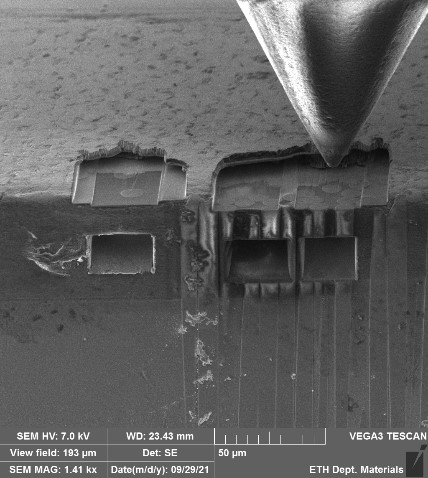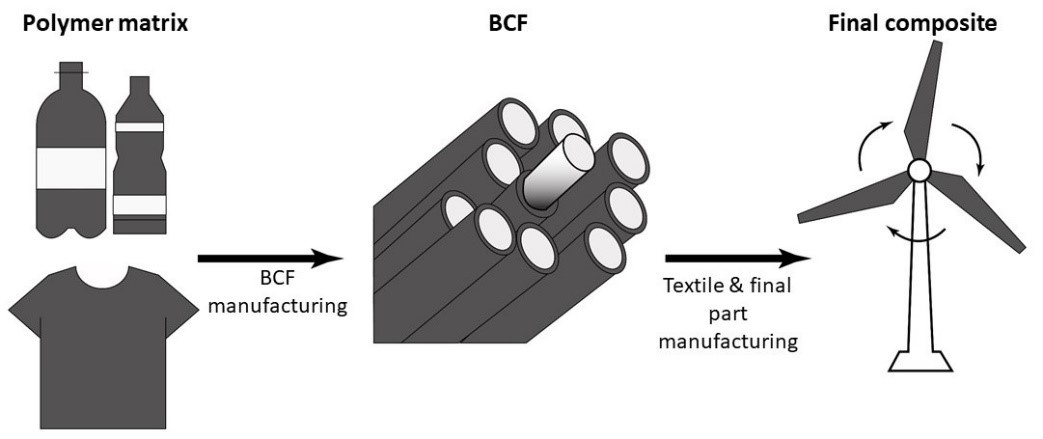Sustainable production of high performance bicomponent fiber
This project investigates novel manufacturing routes to decrease environmental impact and improve performance of bicomponent fiber (BCF), which is an innovative architecture previously developed at CMASLab. The main focus lies on the development, testing and integration of sustainable alternatives to produce this novel intermediate material.
Project Team
- Oliver Vetterli, Doctoral Student
- Paolo Ermanni, Principle Investigator
Contact
Project Duration
2020 to present
Funding Sources
- CMASLab internal funding
Project Description
Thermoplastic composites production and application has risen exponentially in the last decade due to their good performance to price ratio and sustainability potential.
The Laboratory of Composite Materials and Adaptive Structures (CMASLab) has developed an innovative technology that allows the sheathing of single filament with thermoplastic polymer directly in line with the manufacturing of glass fibre; this new architecture is called bicomponent fibre (BCF). This process has enormous advantages during the manufacturing of parts, thanks to good drapeability and intimate mingling of GF and thermoplastic, more complex shapes and better quality can be achieved at a considerably reduced cycle time.
Nonetheless, there are still two main drawbacks that are limiting the wider application of this type of material, namely weak fibre-matrix interface and sustainability.
Sustainable production of High-performance BCF
In order to sustainably produce BCF, the first hurdle to overcome is the coating of high viscosity thermoplastic polymer at high speed onto single glass fibre without breaking it. High performing thermoplastics have high melt viscosity (range of hundreds to thousands Pascal second); to coat these polymers at industrially relevant speed the viscosity can not exceed few Pa*s. To resolve this issue, a polymer solution or a liquid monomer can be added. Though, the first option requires large amount of organic solvent, making it not environmental friendly; and the second long in-situ polymerisation reactions that are not compatible with glass fibre spinning process.
Moreover, in order to prove the sustainability potential of thermoplastics, recycled material instead of virgin resins should be used. These comes with added difficulties, as recycled polymers have lower mechanical properties due to impurities, variability in material and degradation.
The second issue to solve is the weak matrix-fibre interaction. In industry, freshly made glass fibres are coated with a sizing solution. This is a complex mixture of chemicals that has to fulfil multiple tasks, among these, promote matrix fibre interaction. During the manufacturing of BCF, this solution can not be applied due to the addition of the polymer matrix.
Therefore the aim of this project is to overcome current sustainable and performance limitations of BCF manufacturing with an alternative route that would minimize environmental impact and improve matrix-fibre interaction.
Mechanical characterisation of matrix-fibre interaction
To rigorously study the efficacy of the proposed manufacturing routes, the mechanical properties of the interface needs to be assessed locally. Macro-mechanic tests are not well suited for this goal; as these tests analyse the effective behaviour of the final part, it is difficult to isolate local phenomenon. Micromechanics tests, since are carried out on single fiber, have the ability of isolating interface failure. Though, due to the lack of standards, results comparison is difficult, limiting their applicability. Therefore, the goal is to develop a methodology to locally test the interfacial properties and validate the results with standardised tests.



